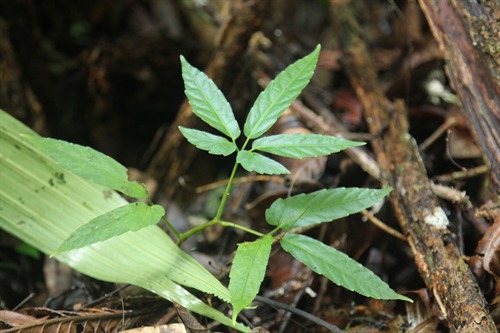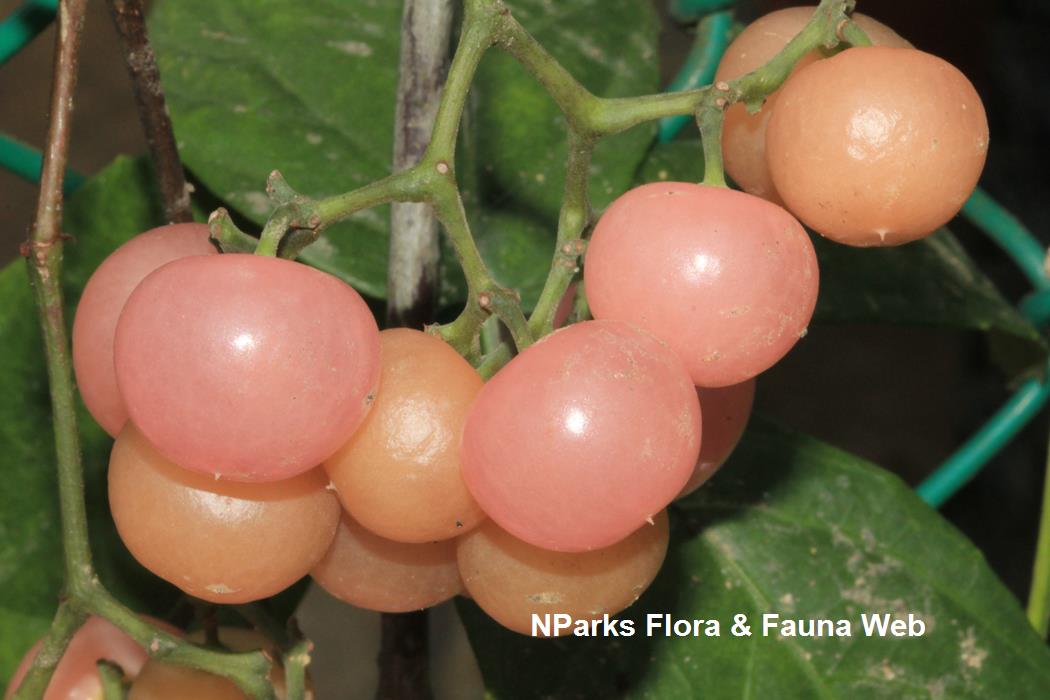
Name
Classifications and Characteristics
| Plant Division | Angiosperms (Flowering Seed Plants) (Dicotyledon) |
|---|---|
| Plant Growth Form | Climber |
| Lifespan (in Singapore) | Perennial |
| Mode of Nutrition | Autotrophic |
| Plant Shape | Irregular |
Biogeography
| Native Distribution | Sumatra, Thailand, Peninsular Malaysia, Singapore, and the Philippines |
|---|---|
| Native Habitat | Terrestrial (Primary Rainforest, Freshwater Swamp Forest) |
| Preferred Climate Zone | Tropical |
| Local Conservation Status | Native to Singapore (Critically Endangered (CR)) |
Description and Ethnobotany
| Growth Form | It is a herbaceous climber. |
|---|---|
| Foliage | Its spirally arranged, stalked leaves have 5–9 toothed-margined leaflets. The terminal leaflet blade is oval to lance-shaped and 8.5–19 by 2–4.5 cm, while the lateral leaflet is lance-shaped and 4–17 by 1.5–5 cm. |
| Flowers | Its stalked flowering shoot arises from the leaf axils. |
| Fruit | Its fruits are round berries, 2–3 cm across, and with 2–4 seeds each. Each seed is 1.5 by 1 cm. |
| Habitat | It grows in all forest types, including lowland dipterocarp forests. It occurs locally in the Nee Soon Swamp Forest. |
| Associated Fauna | Its flowers are pollinated by bees, and its fruits and seeds may be eaten and dispersed by birds. |
| Cultivation | It can be propagated by seeds and from stem cuttings. |
| Etymology | Latin Cayratia, from the Annamese vernacular name, cay-rat, a vine; Latin novem, nine, Latin folium, leaf, referring to the leaves bearing 9 leaflets |
| Ethnobotanical Uses | Medicinal: The plant is used to make tea, and used as a cooling lotion for fever, or made into a poultice for dropsy and boils. |
Landscaping Features
| Landscaping | It is suitable for parks for growing on trellises and pergolas. |
|---|---|
| Desirable Plant Features | Ornamental Flowers, Ornamental Foliage |
| Landscape Uses | Parks & Gardens, Trellis / Arbour / Pergola |
Fauna, Pollination and Dispersal
| Fauna Pollination Dispersal Associated Fauna | Bird-Attracting |
|---|---|
| Pollination Method(s) | Biotic (Fauna) |
| Seed or Spore Dispersal | Biotic (Fauna) |
Plant Care and Propagation
| Light Preference | Full Sun, Semi-Shade |
|---|---|
| Water Preference | Moderate Water |
| Plant Growth Rate | Moderate |
| Rootzone Tolerance | Moist Soils, Well-Drained Soils, Fertile Loamy Soils |
| Propagation Method | Seed, Stem Cutting |
Foliar
| Foliage Retention | Evergreen |
|---|---|
| Mature Foliage Colour(s) | Green |
| Mature Foliage Texture(s) | Papery |
| Foliar Type | Compound |
| Foliar Arrangement Along Stem | Alternate |
| Foliar Attachment to Stem | Petiolate |
| Foliar Shape(s) | Non-Palm Foliage |
| Foliar Venation | Pinnate / Net |
Floral (Angiosperm)
| Flower & Plant Sexuality | Bisexual Flowers |
| Flower Colour(s) | Cream / Off-White |
|---|---|
| Flower Grouping | Cluster / Inflorescence |
| Flower Location | Axillary |
Fruit, Seed and Spore
| Fruit Classification | Simple Fruit |
|---|---|
| Fruit Type | Fleshy Fruit , Non-Accessory Fruit |
Image Repository
Others
| Master ID | 31746 |
|---|---|
| Species ID | 6145 |
| Flora Disclaimer | The information in this website has been compiled from reliable sources, such as reference works on medicinal plants. It is not a substitute for medical advice or treatment and NParks does not purport to provide any medical advice. Readers should always consult his/her physician before using or consuming a plant for medicinal purposes. |

